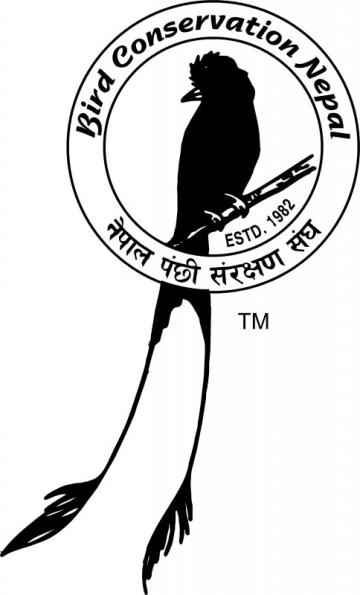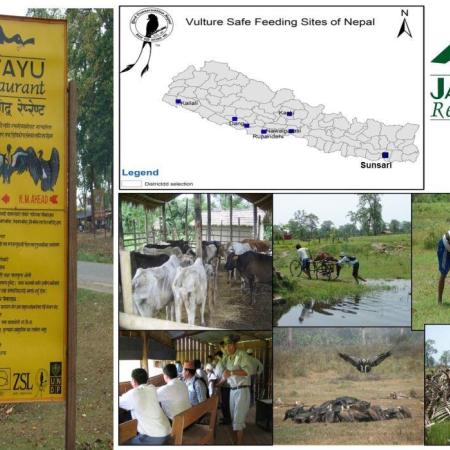
The Vulture's return; Community managed vulture safe zones in Nepal

Gyps vultures nearly went extinct in South Asia in the late 1990s through widespread poisoning by diclofenac. The loss of vultures has resulted in the loss of the ecosystem service they provided – the efficient and safe disposal of carcasses. Vultures out-compete other scavengers; however, their numbers are now so low that they have been replaced by crucially less efficient and less safe scavengers such as dogs, rats etc. This has greatly increased the risk of disease, particularly rabies, and also increased the chances of contamination of water. To conserve these vultures, BCN established Vulture-Safe feeding Sites (VSFS) at Chitwan National park Nepal buffer zone . These are community-run initiatives looking after old and unwanted cattle until their natural death without the use of vulture-toxic NSAIDs to provide to the critically endangered vultures and the people benefit from direct and indirect income generation (sale of milk, hides, bones and manure or to seed micro-enterprises).
Context
Challenges addressed
As vulture is not socially accepted creature among the Hindu community like in Nepal so it was not an easy task to raise awareness among the local communities on their importance and need of their engagement in their conservation. Hence the VSFS was named as "Jatayu restaurant" in Nepali since Jatayu is the vulture in Hindu mythology who saved the goddess Sita. The magic work Jatayu and also support of the local naturalist Dhan Bahadur Choudhary was very instrumental in engaging the local communities in the vulture conservation programme.
Our vulture recovery programme has used a combination of science, advocacy and community engagement to end the veterinary use of vulture-toxic NSAIDs.
For successfully restoring vulture populations our major focus are to empower communities and develop sustainable models to manage Vulture Safe Feeding Sites.
Location
Process
Summary of the process
In our solution, we have a very targeted people (citizen scientists) who very clearly have experienced the population decline of the critically endangered vultures and also the problem of carcass disposal. This group of people are taken on board to manage the community managed vulture safe zone. With the ownership of the management, this group of people have been very supportive in running the conservation programme for the critically endangered vultures. They are now fully recognised nationally and internationally for their pioneer work.
Hence the power of knowledge and ownership have worked very well in our solution
Building Blocks
Local community as a citizen scientists
One of the main building block of this solution is citizen science since the locals were themselves monitoring the vulture colony so it was very easy for them to understand the population decline of the vulture. Also carcass disposal was a burden for them. Citizen science is very useful in mobilising the group to take action in addressing the issue. Hence the same formula was also applied in our solution. The communities were very positive in setting up community managed vulture restaurant. Community managed vulture restaurant consists of a cow shed where old cows are kept till they naturally die and then fed to the vultures in an designated open space. This will let the vultures having the nesting colony there to feed on the safe diclofenac free carcass. In addition to this a bird hide and information center has been established for tourist and general public to see the vultures feeding as well as sharing knowledge on vulture crisis in the country and the conservation effort from the local communities. Communities are also benefiting from the tourism promotion.
Enabling factors
A concept of very simple local action is the enabling factor for the success of this building block. The actions are the same things what a farmer will do in everyday life but have been successful in attracting visitors to the site thus income generation for the locals.
Lesson learned
Institutionalisation of the group and good governance is very important to work with the local community in long run. Long term plan in documented form will be very helpful for good working partnership. Income generating activity should always be linked to involve the locals in long term conservation work.
Community-led management of vulture-Safe Zone
The success of the community managed vulture safe zones is because of the ownership to the local communities. When locals get ownership they feel their rights and are encouraged to invest their resources and time. The locals might take the ownership itself as a reward and their willingness to support the cause will be very high though there is less benefit compared to other thing. Apart from some technical support all the management part was taken by the local communities.
11 member Committee has been formed to manage the vulture safe zone and also a five year management plan is in place. The committee manages the overall setup of the vulture safe zone and are supported by two staff. Tourism promotion, supply of food to vulture and counting of vulture nest and vultures in feeding are the day to day operation of the vulture safe zone.
Enabling factors
The local communities were already organised as being community forest user groups who already own the management of the community forest handed over by the government to them. Hence a small unit within the forest user groups were again organised as a vulture restaurant management committee with operational procedures in place. A small piece of land was also bought for the vulture restaurant. The management committee of the vulture restaurant also managed the local peoples' burden of keeping the unproductive old cows as killing is prohibited.
Lesson learned
There should be a balance of ownership for regulation like in the case of the vulture safe zone the vulture restaurant management committee do not own the land but they have the full management authority so they are very aware that if they do some wrong then the regulatory body may revoke their management authority. Hence there is always a power balance in this type of situation.
Impacts
Hundreds of vultures and people alike have benefited from VSFS. VSFS has set a very good example of community engagement and benefitting from a threatened species conservation and providing good opportunity of learning to students, researchers and other communities. There are over hundred nesting colonies and over 300 vultures of 6 different species feeding the carcass at a time. Over 50,000 national and international visitors have already visited the site. It is also recognised as one of the tourist site by the government and the tour operators. Learning from Nepal has been transferred to other vulture range countries in Asia like India, Pakistan and Bangladesh as well as Africa. VSFS media coverage is among the highest is Nepal.
Beneficiaries
Local communities managing the vulture restaurant and Namuna Bufferzone community forest user groups
Sustainable Development Goals
Story

With known rapid decline of the critically endangered vultures, Bird Conservation Nepal (BCN) started regular monitoring of the species in the country since 2000 with support of its local partners and bird watchers. One of the good nesting colonies of the White rumped Vulture was in Nawalparasi monitored by Dhan Bahadur Chaudhary, nature guide by profession and also a community leader. In 2006, with funding from UNDP/SGP, BCN and the Namuna Community Forest User Groups pioneered the idea of vulture safe feeding sites popularly known as vulture “Jatayu” restaurant in response to the catastrophic decline of formerly common vulture species because of the widespread contamination of cattle carcasses with the veterinary drug diclofenac. The Jatayu restaurant provides safe food close to an existing vulture breeding colony. This has led to the beginning of a recovery in populations of threatened vultures, and is being replicated elsewhere on the Sub-continent.
A vulture restaurant management committee has been established and coordinated by Dhan Bahadur Chaudhary. The committee arranges to collect old and unproductive cattle from the nearby villages, and takes them to a Cow Rescue Centre, where they are looked after. Following their natural deaths, their carcasses are laid out for vultures at the Jatayu restaurant.
A Vulture Information Centre, and a hide from which feeding vultures can be viewed, attract visitors, and spread knowledge of the importance of vultures in maintaining a healthy environment, free of decaying carcasses and associated infections and pests such as feral dogs. In addition to conserving vultures, the vulture restaurant provides sustainable livelihoods through ecotourism. Dhan Bahadur Chaudhary has played key role in promoting ecotourism integrated with the culture of local indigenous people and the biodiversity of the area.
In addition to this inspiring conservation work the communities are now helping with the conservation of grassland birds and mammals, delivering sustainable livelihoods to communities including excluded castes, and providing a happy (and eventually useful) retirement and death for cows which have reached the ends of their productive lives.

